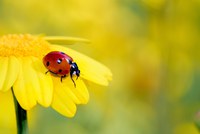Dakota Gardener: Do not buy ladybugs
(Click an image below to view a high-resolution image that can be downloaded)
By Tom Kalb, Horticulturist
NDSU Extension
The ladybug is a gardener’s best friend.
This beneficial insect is like the sheriff in our gardens, protecting our plants from aphids and other bad bugs.
Ladybugs have voracious appetites, too. One ladybug can eat 50 aphids a day and over 5,000 aphids in its lifetime.
Although ladybugs are our friends, don’t buy them for your garden. You will be wasting your money.
There are dozens of different species of ladybugs (more properly called lady beetles) in the Dakotas. The most commonly sold lady beetle is the convergent lady beetle.
These lady beetles eat heartily during autumn in the valleys of the western United States, develop a fat layer in their bodies and then fly up nearby mountains to hibernate.
The beetles sleep together in huge clusters of up to 40 million. While sleeping, they are harvested with portable vacuums, refrigerated and then packaged for sale.
The biggest problem with buying lady beetles is the insects still think they are hibernating in the mountains. When they wake up in nature, they migrate for miles down to the valley before feeding again.
The same thing happens with purchased lady beetles. Studies have shown that purchased lady beetles will fly for miles after being released, burning up their fat layers before eating insects or laying eggs.
Within 48 hours, less than 5% of the lady beetles you release in your garden will remain. Some of these may have been injured when shipped.
Even if a few lady beetles remain for a few days, they are not hungry and are not likely to lay eggs in your garden.
In general, buying lady beetles and other predatory beneficial insects have their limitations in open gardens. You need to have lots of pests in your garden for the predators to eat. Once these pests are eaten, the predatory insects will fly away from your garden to look for more food.
Concerns have been raised that the natural habitat of lady beetles is being damaged in harvesting operations. Furthermore, scientists have expressed concerns that the distribution of harvested lady beetles across our country can spread parasites to our local lady beetles.
Another limitation is the convergent lady beetle almost exclusively eats aphids. It doesn’t like to eat cabbageworms, potato beetles or cutworms, for example.
Instead of buying sleeping lady beetles from California, it makes more sense to provide an environment that is inviting to our local lady beetles.
Lady beetles will feed on nectar and pollen. You can attract them with flowers such as dill, coriander, alyssum, sunflower and yarrow.
Minimize the use of persistent insecticides that threaten our lady beetles. If a pest outbreak occurs, use a short-lived and relatively safe insecticide. Spinosad and neem can kill pests while posing a minimal risk to lady beetles.
Lady beetles are our best friends. You can’t buy friendship. Best friends are priceless.
For more information about gardening, contact your local NDSU Extension agent. Find the Extension office for your county at www.ndsu.edu/agriculture/extension/county-extension-offices.
NDSU Agriculture Communication – June 6, 2023
Source: Tom Kalb, 701-328-9722, tom.kalb@ndsu.edu
Editor: Kelli Anderson, 701-231-7881, kelli.c.anderson@ndsu.edu




